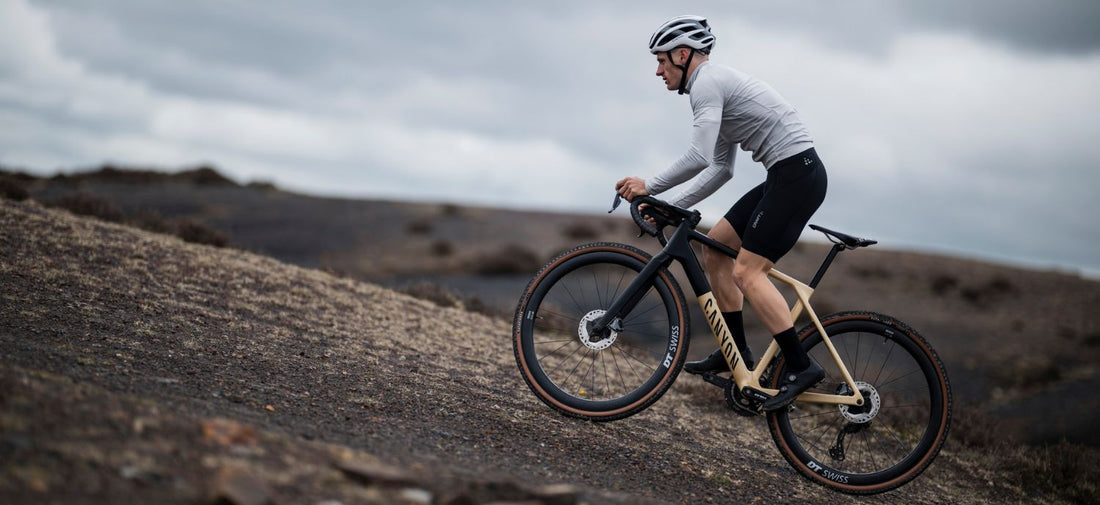
Cycling Injuries and how to prevent them
Cycling is a fantastic sport to explore the outdoors,but injuries like knee pain, saddle sores, and numb toes can limit your enjoyment and performance. This guide outlines typical cycling injuries, their causes, and how to prevent them, including the role of supportive insoles.
Common Cycling Injuries
The most common injuries you may encounter while cycling include:
- Knee pain
-
Saddle sores
-
Lower back and neck strain
- Numb toes and Achilles tendon pain
These can occur whether you're commuting to school or work, or out on long rides. So experiencing one or more of these injuries isn’t necessarily related to your cycling experience.
Main Causes of Cycling Injuries
Cycling injuries often result from a combination of equipment issues, technique errors, and physical factors. Here’s a breakdown of the main causes and why they matter:
Poor bike fit and bad riding posture
A saddle that is too high or too low can cause knee pain, while using a stem that is too short or too long can lead to back and neck discomfort. Additionally, hunching your shoulders can worsen these issues.
Repetitive motion and muscular imbalances
Since pedaling is a repetitive motion, it can overwork certain muscle groups while underutilizing others. This leads to muscular imbalances such as tight quadriceps or weak glutes, which can cause joint misalignment and long-term pain.
Improper footwear or saddle setup
Most cycling shoes offer little foot support, which can lead to misalignment of the feet, knees, and hips. The same goes for the saddle, it should fit your sit bones to avoid restricted movement and pressure on sensitive areas.

Tips to prevent common and long-term cycling injuries
Feeling pain while cycling can be a major obstacle if you love spending time on the bike. To prevent discomfort or speed up recovery after an injury, the following tips might help:
Stretch regularly and build strength
Dynamic stretches before your ride (e.g., leg swings, hip circles) prepare your muscles, while longer static stretches afterward (e.g., hamstring and quad stretches) help reduce tightness and improve flexibility. Strengthening your core, glutes, quads, and hamstrings stabilizes your joints and boosts pedaling efficiency. Exercises like planks, squats, and lunges enhance muscle balance. Yoga is also great for combining stretching and strength training.
Monitor your training load
Overtraining can cause overuse injuries. Gradually increase your mileage and intensity, and include rest days. Pay attention to early signs of discomfort instead of pushing through pain.
Optimize your bike setup
Make sure your saddle height, handlebar position, and cleat alignment suit your body and flexibility. Make small adjustments and test them on your next ride. Ideally, get a professional bike fitting that addresses all contact points with the bike.

Do Insoles Help Prevent Cycling Injuries?
Insoles can be a game-changer for many cyclists, offering benefits beyond comfort. Here’s what high-quality cycling insoles like SOLESTAR BLK and SOLESTAR Kontrol can do:
Improve joint alignment
Good cycling insoles offer rigid, anatomical arch support that stabilizes the entire foot. This helps align your ankles, knees, and hips while pedaling, preventing injuries caused by joint misalignment, like knee pain.
Relieve pressure and reduce fatigue
Insoles evenly distribute pressure across the foot, reducing hot spots, numbness, and discomfort. Supporting the foot’s natural position also reduces fatigue in the feet and calves, allowing longer rides.
Enhance power and control
A stable foot increases power transfer to the pedal, making your pedal strokes more efficient. Insoles also reduce unwanted foot movement in the shoe, preventing blisters and improving overall control.
Increase comfort
Beyond performance, insoles also improve shoe comfort — helping you enjoy your time on the bike more.
Choosing the right cycling insoles
Look for insoles with a rigid base and anatomical arch support. Avoid overly soft models, they lack the structure needed for repetitive pedaling and joint stability.
SOLESTAR insoles are designed specifically for cyclists. They feature a rigid carbon fiber base and anatomical support that stabilizes the foot and reduces unnecessary movement. This helps reduce strain on the knees and hips. By optimizing foot alignment and power transfer, SOLESTAR insoles help prevent overuse injuries like knee pain and Achilles tendinitis, making them a top choice for injury-conscious cyclists.
If you have questions, you can contact us at: info@solestar.com


